1. Lunar Module Launch Vehicle (LMLV): India’s Heaviest Rocket – Science & Technology
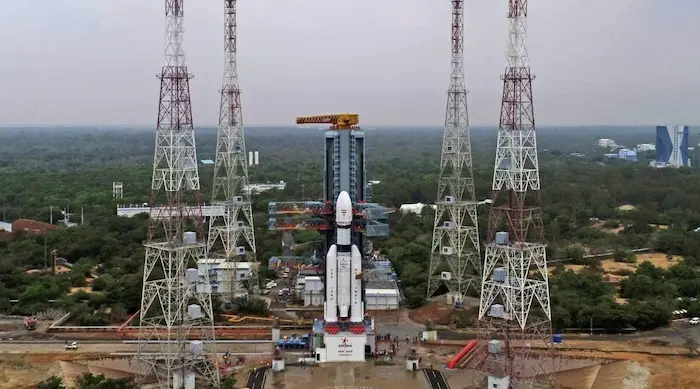
Why in News?
The Indian Space Research Organisation (ISRO) is developing its heaviest rocket to date, the Lunar Module Launch Vehicle (LMLV), designed to advance India’s ambitions in lunar exploration, human spaceflight, and deep space missions.
Expected completion: by 2035, with human lunar mission planned for 2040.
Key Takeaways
1. What is LMLV?
- A super heavy-lift, partially reusable rocket.
- Designed for lunar exploration and long-term human space programs.
- Will replace the Next Generation Launch Vehicle (NGLV).
- Height: As tall as a 40-storey building – far larger than India’s current LVM-3.
2. Payload Capacity
- 80 tonnes to Low Earth Orbit (LEO)
- 27 tonnes to the Moon
- Human crew modules: 18–20 tonnes capacity
This makes it comparable to the NASA SLS (Space Launch System) and SpaceX Starship, placing India among advanced spacefaring nations.
3. Design Features
- Three-stage rocket:
- Stage 1 & 2: Liquid propellants
- Stage 3: Cryogenic stage
- Strap-on boosters taller than the entire LVM-3 rocket.
- 27 engines in the first stage (core + boosters).
- Partially reusable to cut down launch costs.
4. Planned Missions with LMLV
- Human Lunar Mission (by 2040)
- Carrying crew modules (18–20 tonnes) for India’s first astronaut landing on the Moon.
- Bharatiya Antariksh Station (BAS, by 2035)
- Deployment of five heavy modules for India’s first space station.
- Lunar Cargo Missions
- Transport 27 tonnes of cargo for lunar surface infrastructure (habitats, logistics).
- Deep Space Exploration (2040s)
- Potential for Mars, Venus, and interplanetary missions due to high lift capacity.
5. Strategic Significance
- Boosts India’s space profile: From satellite launches to human and interplanetary exploration.
- Reduces dependence on foreign rockets for heavy payload launches.
- Strengthens space economy: Potential collaborations with NASA, ESA, JAXA.
- Supports Viksit Bharat 2047 by projecting India as a major global space power.
Comparison with Other Heavy-Lift Rockets
| Country | Rocket | Payload to LEO |
|---|---|---|
| USA | SpaceX Starship | 100–150 tonnes |
| USA | NASA SLS | 95–130 tonnes |
| China | Long March 9 (planned) | ~140 tonnes |
| India | LMLV (planned) | 80 tonnes |
Though smaller than Starship or SLS, LMLV will make India the 4th nation with super heavy-lift capability.
Exam Connect – Possible Questions
Prelims
- The Lunar Module Launch Vehicle (LMLV), recently in news, is designed for which of the following?
A. Only satellite launches into LEO
B. Human lunar and deep space missions
C. Missile defence system
D. Ocean exploration
Answer: B. Human lunar and deep space missions
- Which ISRO rocket will LMLV replace?
A. PSLV
B. GSLV Mk II
C. Next Generation Launch Vehicle (NGLV)
D. LVM-3
Answer: C. Next Generation Launch Vehicle (NGLV)
- Arrange the following in descending order of payload capacity (to LEO)
1. NASA SLS
2. ISRO LMLV
3. SpaceX Starship
4. LVM-3
A. 3 > 1 > 2 > 4
B. 1 > 3 > 2 > 4
C. 2 > 3 > 1 > 4
D. 3 > 2 > 1 > 4
Answer: A. 3 > 1 > 2 > 4
Mains
- “The Lunar Module Launch Vehicle (LMLV) marks a paradigm shift in India’s space ambitions.” Discuss its significance for India’s lunar program and space station plans.
- Compare ISRO’s LMLV with NASA’s SLS and SpaceX’s Starship in terms of design philosophy, payload capacity, and mission goals. What lessons can India learn from global heavy-lift programs?
- Evaluate the role of heavy-lift launch vehicles in expanding space diplomacy and the global space economy. How can LMLV support India’s rise as a space power by 2047?
2. UGC Draft Curriculum Highlights Ancient Wisdom in Higher Education – History & Culture
Why in the News?
The University Grants Commission (UGC) has released a draft undergraduate curriculum framework integrating Indian Knowledge Systems (IKS) into higher education.
- Aim: To align education with India’s cultural and intellectual heritage, as envisioned in NEP 2020.
- Feedback from stakeholders is being sought before final adoption.
Key Takeaways
1. Context: Indian Knowledge Systems (IKS)
- Rooted in Vedas, Upanishads, Ayurveda, Arthashastra, temple architecture, classical sciences etc.
- Emphasizes holistic learning, ethics, sustainability, and cultural rootedness.
- NEP 2020 encouraged mainstreaming IKS to “decolonize curricula” and revive indigenous perspectives.
2. Subject-wise Integration of IKS
| Discipline | Proposed IKS Integration |
|---|---|
| Mathematics | Mandala geometry, yantras, study of temple architecture using āyādi ratios |
| Commerce | Gurukul system values, Bhartiya philosophy, ethical leadership, sustainability |
| Economics | Dharmic perspectives on wealth, trade ethics, Arthashastra-based principles |
| Chemistry | Study of traditional fermented beverages, ancient concepts of the atom |
| Anthropology | Teachings of Charaka & Sushruta on health, culture-nature relationship |
The intent is not replacement, but blending traditional wisdom with modern educational outcomes.
3. Philosophical Shift
- From Colonial Legacy → Culturally Rooted Curriculum
- From Purely Western Canon → Balanced with Indigenous Traditions
- Encourages ethical, sustainable, holistic learning alongside scientific inquiry.
4. Significance of the Draft
- Cultural Revival: Promotes pride in India’s civilizational knowledge.
- Global Relevance: Showcases indigenous contributions to mathematics, medicine, philosophy, and sciences.
- Ethical Dimension: Encourages responsible and sustainable practices in commerce, economics, and environment.
- Decolonization of Knowledge: Counters the Eurocentric bias of academia.
5. Concerns Raised
- Risk of romanticizing tradition without rigorous evaluation.
- Need to balance cultural heritage with scientific inquiry and critical thinking.
- Implementation challenges: training faculty, creating updated material, avoiding dogma.
- Debate over whether it could politicize education.
Broader Context
- Other countries (China, Japan) integrate indigenous philosophies into curricula to preserve heritage while modernizing education.
- India’s move could create globally distinct, culturally rooted graduates, while contributing to soft power diplomacy.
Exam Connect – Possible Questions
Prelims
- Which education policy explicitly recommended integrating Indian Knowledge Systems (IKS) into curricula?
A. NEP 1968
B. NEP 1986
C. NEP 2005
D. NEP 2020
Answer: D. NEP 2020
- Which ancient Indian texts are most directly associated with traditional medicine and anthropology?
A. Rigveda and Samaveda
B. Charaka Samhita and Sushruta Samhita
C. Arthashastra and Manusmriti
D. Kalpasutra and Sangam texts
Answer: B. Charaka Samhita and Sushruta Samhita
- The concept of āyādi ratios, often applied in temple architecture, is associated with which discipline?
A. Physics
B. Mathematics and Geometry
C. Ayurveda
D. Astronomy
Answer: B. Mathematics and Geometry
Mains
- “The integration of Indian Knowledge Systems (IKS) into higher education is both a cultural necessity and an academic challenge.” Discuss.
- Examine the role of ancient Indian contributions in mathematics, medicine, and economics. How can these be meaningfully integrated into modern curricula without compromising scientific rigor?
- Critically analyse the UGC’s draft framework on IKS in the context of NEP 2020. How can India strike a balance between traditional wisdom and modern educational standards?
3. Integrated Food Security Phase Classification (IPC) and Famine Declaration in Gaza – International Relations
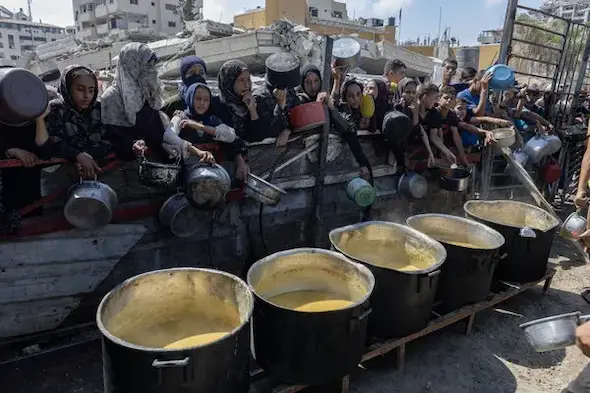
Why in News?
The United Nations has officially declared a famine in Gaza, based on an assessment by the Integrated Food Security Phase Classification (IPC) panel.
- This marks one of the gravest humanitarian crises in recent years.
- Declaration aims to mobilize global aid, emergency operations, and donor support.
Key Takeaways
1. What is IPC?
- Full Form: Integrated Food Security Phase Classification.
- Established: 2004, during Somalia food crisis.
- Developed by: Famine Early Warning Systems Network (FEWS NET) and partners.
- Coordinated by: FAO (Food and Agriculture Organization, UN).
- Purpose:
- Provide standardized method for food insecurity assessment.
- Enable early warnings and evidence-based decisions.
- Facilitate coordinated humanitarian responses.
2. How Does IPC Work?
- Partnership Model: Brings together UN agencies, NGOs, governments, academia.
- Methodology: Uses data on:
- Food access & consumption
- Livelihood security
- Nutrition levels
- Mortality rates
- Outputs:
- Real-time assessments
- 6-month forecasts for preventive action
- Consensus-Based: Requires technical agreement among analysts for credibility and transparency.
3. Five-Phase IPC Classification
| Phase | Description |
|---|---|
| Phase 1 | Minimal (adequate food security) |
| Phase 2 | Stressed (reduced food access, livelihood pressure) |
| Phase 3 | Crisis (food gaps, acute malnutrition begins) |
| Phase 4 | Emergency (high acute malnutrition, excess mortality) |
| Phase 5 | Catastrophe/Famine (widespread death, collapse of livelihoods) |
4. When is a Famine Declared? (IPC Phase 5 Criteria)
- At least 20% of households face extreme food gaps.
- At least 30% of children under 5 suffer from acute malnutrition (wasting).
- Mortality rate: 2 adults or 4 children per 10,000/day.
Declaration triggers global emergency responses – food aid, medical relief, funding campaigns.
5. Past Famine Declarations
- Somalia (2011) – ~260,000 deaths.
- South Sudan (2017, 2020) – prolonged civil conflict + climate crisis.
- Darfur, Sudan (2024) – displacement & war-related crisis.
- Gaza (2025) – latest humanitarian emergency.
Significance of Famine Declarations
- Mobilizes global aid through UN and humanitarian partners.
- Raises international pressure on warring parties or governments.
- Informs donors and NGOs of severity, ensuring faster funding.
- Brings global media attention to humanitarian crises.
Exam Connect – Possible Questions
Prelims
- The Integrated Food Security Phase Classification (IPC) is coordinated by which international body?
A. UNEP
B. FAO
C. WFP
D. IFAD
Answer: B. FAO
- Which of the following is NOT a criterion for declaring famine under IPC Phase 5?
A. 20% of households facing extreme food gaps
B. 30% of children under 5 with acute malnutrition
C. Mortality rate of 2 adults/4 children per 10,000/day
D. GDP contraction of 10% in affected country
Answer: D. GDP contraction of 10% in affected country
- Arrange the following in order of severity under IPC classification:
1. Emergency
2. Minimal
3. Crisis
4. Famine
A. 2 → 3 → 1 → 4
B. 2 → 1 → 3 → 4
C. 3 → 2 → 4 → 1
D. 1 → 2 → 3 → 4
Answer: A. 2 → 3 → 1 → 4
Mains
- “The famine in Gaza highlights the intersection of conflict and food insecurity.” Discuss the role of IPC in international humanitarian responses.
- Explain the methodology and significance of the Integrated Food Security Phase Classification (IPC) in ensuring timely international aid interventions.
- India has successfully transformed from a food-deficit to a food-surplus nation. How can India’s experience contribute to global food security, especially in conflict zones?
4. Lipulekh Pass: Current Developments – International Relations
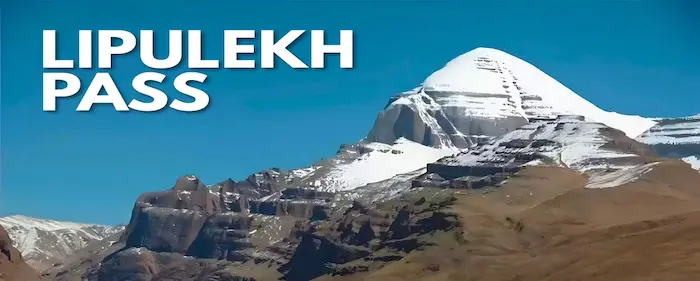
Why in News?
India has formally rejected Nepal’s objections regarding the resumption of border trade with China through Lipulekh Pass (Uttarakhand).
- The trade route had been suspended during the COVID-19 pandemic, but has now reopened.
- Nepal has reiterated its territorial claims over Lipulekh, Kalapani, and Limpiyadhura, reviving an old boundary dispute.
Key Takeaways
1. About Lipulekh Pass
- Location: Kumaon region, Uttarakhand (near Pithoragarh district).
- Altitude: ~17,000 feet (5,200 m).
- Connects: India → Taklakot (Purang) in Tibet, China.
- Importance:
- Strategic trijunction: India–China–Nepal.
- Pilgrimage route: Shortest and most popular route to Kailash Mansarovar.
- Trade link: Historically part of the India–China trade route since 1954.
2. Strategic Importance for India
- Border management: Critical for surveillance against China in the Himalayas.
- Connectivity: Supports trade, defence logistics, and pilgrim movement.
- Geopolitical leverage: Strengthens India’s hold over sensitive Himalayan frontiers.
3. India–Nepal Boundary Dispute (Limpiyadhura–Lipulekh–Kalapani)
- Origin: Treaty of Sugauli (1815–16) signed after the Anglo-Nepalese War.
- Defined Nepal’s western boundary at the Kali (Mahakali) River.
- India’s Position:
- Claims Kali River originates near Lipulekh, placing Lipulekh & Kalapani inside Indian territory.
- Points to British-era maps & administrative records supporting Indian sovereignty.
- Nepal’s Position:
- Argues the Kali originates further west at Limpiyadhura, extending Nepal’s claim.
- In 2020, Nepal released a new political map including Limpiyadhura–Lipulekh–Kalapani as part of its territory.
- Disputed Area: ~370 sq. km currently under Indian administration since the 19th century.
4. India–Nepal Border Dynamics
- Shared boundary: 1,770 km across 5 Indian states – Uttarakhand, Uttar Pradesh, Bihar, West Bengal, Sikkim.
- Features:
- Open border system (visa-free movement).
- Deep cultural, religious, and economic linkages.
- Challenges:
- Periodic border disputes strain bilateral relations.
- Nepal’s strategic balancing between India and China.
5. Diplomatic Implications
- For India:
- Lipulekh is vital for defence and trade with China.
- Rejecting Nepal’s claims reaffirms sovereignty but risks diplomatic tensions.
- For Nepal:
- The issue is tied to national identity and domestic politics.
- China’s growing influence complicates Kathmandu’s balancing act.
The dispute highlights the complex geopolitics of the Himalayas, where history, geography, and strategic interests intersect.
Exam Connect – Possible Questions
Prelims
- The Treaty of Sugauli (1815–16), central to the Lipulekh dispute, was signed between:
A. British East India Company and China
B. British East India Company and Nepal
C. India and Nepal after Independence
D. Nepal and Tibet
Answer: B. British East India Company and Nepal
- Which of the following passes connect India with Tibet (China)?
1. Lipulekh Pass
2. Shipki La
3. Nathu La
4. Rohtang La
Options:
A. 1, 2, 3 only
B. 1 and 4 only
C. 2, 3, 4 only
D. 1, 2, 3, 4
Answer: A. 1, 2, 3 only
- The Lipulekh Pass is strategically important because it lies near the trijunction of:
A. India–Nepal–Bhutan
B. India–China–Nepal
C. India–China–Bhutan
D. India–China–Pakistan
Answer: B. India–China–Nepal
Mains
- “Lipulekh Pass has become a focal point of India–Nepal–China geopolitics.” Examine the historical roots and present implications of the dispute.
- Discuss the significance of Himalayan passes like Lipulekh in India’s strategic, cultural, and economic relations with its neighbours.
- India and Nepal share a historically close relationship, yet boundary disputes often strain ties. Suggest a framework to resolve the Limpiyadhura–Lipulekh–Kalapani dispute while preserving bilateral goodwill.
5. AI and the Future of Work in India – Towards Inclusive Growth – Economy
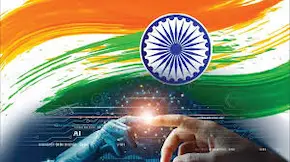
Why in News?
Artificial Intelligence (AI) is reshaping global economies and work structures. In India, with its large workforce and rising digital economy, the key challenge is ensuring that AI adoption leads to inclusive growth, not widening inequality.
By 2030, AI is expected to reshape 10.35 million jobs while creating 3 million new tech roles in India.
Key Takeaways
1. AI’s Potential Impact on Jobs
- ILO (International Labour Organisation): AI will transform jobs rather than eliminate them entirely.
- India’s projections:
- 10.35 million jobs reshaped
- 3 million new AI-driven roles (data science, machine learning, cybersecurity, etc.)
- Labour-intensive sectors (retail, logistics, BPOs, tourism) are most vulnerable.
- Agriculture: Minimal penetration of AI, but potential for smart farming in future.
2. Automation vs. Augmentation
| Approach | Outcome |
|---|---|
| Automation | Machines replace human workers → job losses, inequality |
| Augmentation | AI complements human skills → productivity boost + job retention |
- Daron Acemoglu (Nobel Laureate) warns against the “automation trap” → policy must push AI towards augmentation, not blind replacement.
3. Policy Priorities for Inclusive AI
- Skill Development & Lifelong Learning
- Integrate AI & digital literacy into school and higher education (NEP 2020 alignment).
- Expand skilling/reskilling programs (Skill India, Digital India, PM Kaushal Vikas Yojana).
- MSME-Centric AI Adoption
- Tailored AI tools for small businesses.
- Subsidized training to make MSMEs AI-ready.
- Promoting Innovation Ecosystem
- Scale-up Atal Innovation Mission & Startup India for AI-based entrepreneurship.
- Develop vernacular AI tools & Small Language Models (SLMs) for rural inclusivity.
- Preventing Monopolies
- Ensure open APIs & interoperability for AI systems.
- Guard against domination by a few global AI giants.
4. Ensuring Competitive & Inclusive AI Ecosystem
- Encourage public-private partnerships for AI in education, health, governance.
- Promote ethical AI use (transparency, privacy safeguards).
- Localize AI in vernacular languages to reach rural and semi-urban India.
Why It Matters for India
- India has the world’s youngest workforce → opportunity to be a global AI hub.
- AI can support “Viksit Bharat 2047” by boosting productivity in manufacturing, healthcare, agriculture, logistics, and governance.
- But without policy safeguards, AI could exacerbate inequality, unemployment, and digital divides.
Exam Connect – Possible Questions
Prelims
- Which international organization developed the projection that AI will reshape jobs rather than eliminate them?
A. IMF
B. World Bank
C. ILO
D. WTO
Answer: C. ILO
- The term “automation trap,” often used in the context of AI and employment, is associated with which economist?
A. Amartya Sen
B. Joseph Stiglitz
C. Daron Acemoglu
D. Abhijit Banerjee
Answer: C. Daron Acemoglu
- Which of the following Indian initiatives directly supports AI-driven innovation and startups?
1. Atal Innovation
2. MissionDigital India
3. Startup India
4. National Food Security Mission
Options:
A. 1, 2, 3 only
B. 1 and 4 only
C. 2 and 3 only
D. 1, 2, 3, 4
Answer: A. 1, 2, 3 only
Mains
- “The future of work in India will depend on whether AI is harnessed for augmentation or automation.” Discuss in the context of inclusive growth and employment generation.
- Examine the opportunities and challenges AI presents to labour-intensive sectors in India. How can policy ensure that AI adoption benefits both workers and employers?
- India aims to be a global AI hub by 2047. Evaluate the reforms needed in education, MSME support, and innovation ecosystems to achieve this vision.
6. NITI Aayog Proposes Model Framework for Homestays – Governance
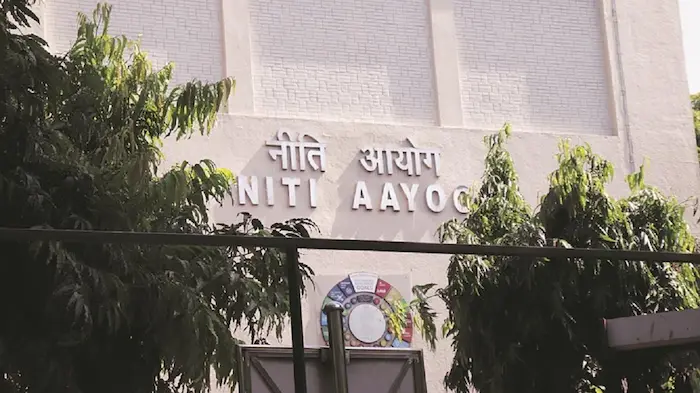
Why in News?
NITI Aayog has released a report “Rethinking Homestays: Navigating Policy Pathways”, proposing a model framework for homestays and BnBs to:
- Harmonize state regulations
- Unlock the economic potential of community-based tourism
- Support sustainable and inclusive development
Key Takeaways
1. Tourism Sector in India – Recent Trends
- Post-pandemic revival driven mainly by domestic tourism.
- In 2024, the travel & tourism sector contributed ₹21.15 lakh crore to the economy — 21% higher than 2019 levels.
- Shift from luxury hotels to alternative accommodations like homestays and BnBs.
2. Why Homestays Matter?
| Aspect | Significance |
|---|---|
| Economic Potential | Job creation, women-led entrepreneurship, boosts local income |
| Cultural Value | Offers authentic experiences, cultural immersion |
| Sustainability | Low ecological footprint, promotes rural/eco-tourism |
| Regional Development | Encourages dispersal of tourism beyond metros into rural/semi-urban areas |
3. Core Recommendations of the Report
- Light-Touch Regulatory Framework
- Simplify registration/licensing to encourage participation.
- Harmonize state-level laws to reduce compliance burden.
- Digital Empowerment
- Centralized digital portal for host registration, training, and grievance redressal.
- Integration with incredibleindia.org and global platforms.
- Capacity Building for Hosts
- Training in hospitality, hygiene, digital literacy, and financial management.
- Partnerships with local universities & skill councils.
- Financial Incentives & Support
- Destination-level funding for clusters (not just individuals).
- Encourage credit access and insurance schemes for homestay owners.
- Cultural Authenticity & Branding
- Position homestays as “experience tourism” (food, crafts, folklore).
- Develop regional tourism circuits around homestays.
4. Policy Goal
- Position homestays as a pillar of sustainable tourism, not just a low-cost accommodation option.
- Align with NEP 2020’s focus on vocational training & entrepreneurship and Atmanirbhar Bharat’s rural empowerment vision.
Broader Significance
- Supports SDG 8 (Decent Work & Economic Growth) and SDG 11 (Sustainable Cities & Communities).
- Helps India diversify its tourism sector, competing with global models in Bhutan, Nepal, Japan where community-based tourism is thriving.
- Can strengthen India’s soft power by showcasing local traditions to international visitors.
Exam Connect – Possible Questions
Prelims
- According to the NITI Aayog report “Rethinking Homestays,” which of the following is recommended for developing India’s homestay ecosystem?
1. Light-touch regulations
2. Centralized digital portal
3. Large-scale government ownership of homestays
4. Capacity building of hosts
Options:
A. 1, 2, 4 only
B. 1, 3, 4 only
C. 2 and 3 only
D. 1, 2, 3, 4
Answer: A. 1, 2, 4 only
- Which of the following UN Sustainable Development Goals (SDGs) is most directly linked to the promotion of homestays?
A. SDG 2 – Zero Hunger
B. SDG 8 – Decent Work & Economic Growth
C. SDG 14 – Life Below Water
D. SDG 16 – Peace, Justice & Strong Institutions
Answer: B. SDG 8 – Decent Work & Economic Growth
- India’s tourism sector contributed approximately how much to the economy in 2024, according to NITI Aayog’s report?
A. ₹11.5 lakh crore
B. ₹15.2 lakh crore
C. ₹21.15 lakh crore
D. ₹25 lakh crore
Answer: C. ₹21.15 lakh crore
Mains
- “Homestays have the potential to transform Indian tourism into an engine of inclusive and sustainable development.” Discuss in light of NITI Aayog’s model framework.
- Evaluate the role of homestays in promoting cultural preservation and rural entrepreneurship. How can states ensure quality and standardization without overregulation?
- Community-based tourism initiatives like homestays can reduce urban-rural disparities. Critically examine their potential and limitations in the Indian context.

